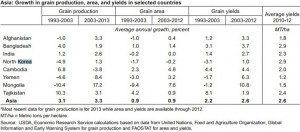According to the Institute for Far Eastern Studies (IFES):
Grain Imports Decrease, Rare-Earth Mineral Exports Increase in the First Half of 2014
It has been reported that Chinese grain imports in North Korea have fallen drastically in the first half of 2014. According to the Korean Foreign Trade Association (KFTA), Chinese exports of grain to North Korea totaled 58,387 tons in the first half of 2014, totaling a mere 47 percent of the grain exported in the first half of the previous year (124,228 tons).
China’s most heavily exported grain product to North Korea is flour, which made up 68.8 percent (40,142 tons) of all total grain exports for the first half of 2014. China also exported 13,831 tons of rice and 3,420 tons of corn to North Korea. Corn exports did not even reach twenty percent of the amount exported at the same time last year (17,655 tons).
It is postulated that China’s sharp decrease in grain exports to North Korea is due to the souring relations between the two nations in 2014. Another theory is that the decrease in exports could be due to North Korea’s recent increase in agricultural productivity over previous years.
In the first half of 2014 China exported 109,531 tons of fertilizer to North Korea, 21.3 percent less than the amount exported during the same timeframe last year (139,161 tons). In the first three months of 2014, North Korea aggressively imported Chinese fertilizer at a rate of twenty thousand tons over its monthly average. However, this decreased markedly in the months of April, May and June.
Meanwhile, North Korea has been exporting large quantities of rare-earth resources (which are used in manufacturing high-tech products) to China over the last few months. Reportedly, in May of 2014, North Korea exported 550,000 dollars’ worth of rare-earth ore to China. This figure more than doubled the following month, reaching 1.33 million USD in June.
This comes as a bit of a surprise, as North Korean rare-earth resource exports to China had come to a standstill after the first round of exports (totaling 24.7 thousand USD) in January 2013. Suddenly, after fifteen months, North Korea has exported 1.88 million USD worth of rare-earth ore (approx. 1.93 billion KRW, 62.66 thousand kilograms) over the last two months.
Since 2011, North Korea has in fact been exporting rare-earth carbonate mixtures to China; however total exports of these products have only reached 170 thousand USD over the last three and a half years.
North Korea has been placing attention on these underground rare-earth resources, of which the nation reportedly has ample quantities of in various deposits around the country. Recently, much effort has been put into surveying for deposits of these so-called “vitamins of the 21st century’s high-tech industry.” In 2013 a company for the development of rare-earth materials in North Pyongan Province was established with the cooperation of the international private equity firm “SRE Minerals.”
In July 2011, the Choson Sinbo, a news affiliate of the General Association of Korean Residents in Japan, reported in an interview with top executives from the National Resources Development Council that rare-earth resource deposits in North Korea total approximately 20 million tons. The drastic increase seen in rare-earth resource exports can be attributed to North Korea’s attempt to diversify its resource exports. In other words, the DPRK is investing in rare-earth material exports in order to reduce its dependency on other leading mineral exports such as anthracite, iron ore, and lead.
Exports of anthracite to China decreased by 23 percent in the first half of 2014 (compared to last year), totaling approximately 571 million USD. Iron ore exports, North Korea’s second leading resource export, reached approximately 121 million USD in the same time period – a drop of 5 percent when compared to the same time period last year.
According to the Korea Herald (Yonhap):
North Korea’s trade with its economic lifeline China fell 2.1 percent on year to US$2.89 billion in the first six months of this year, data compiled by South Korea’s government trade agency showed Monday, in another sign that strained political ties between the two nations have affected their economic relations.
During the six-month period, North Korea’s exports to China declined 3.9 percent to $1.31 billion and imports slipped 0.6 percent to $1.58 billion, according to the data provided by the Beijing unit of South’s Korea Trade and Investment Promotion Agency (KOTRA).
There were no shipments of crude oil from China to North Korea from January to June, the data showed.
…
“Despite the six-month absence of oil shipments, the scale of North Korea’s decline in imports is minimal,” the source said on condition of anonymity.
Meanwhile, North Korea’s exports of rare earth to China jumped 153.7 percent on year during the January-June period, the data showed, without providing the value of the exports.
Read the full story here:
N. Korea’s trade with China falls 2.1 pct in H1
Korea Herald (Yonhap)
2014-08-04

